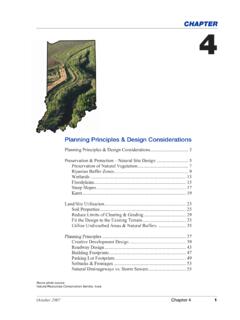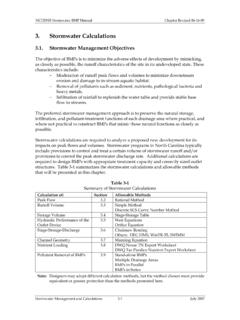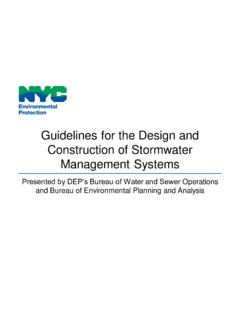Transcription of National Standards for sustainable drainage systems
1 National Standards for sustainable drainage systems Designing, constructing, operating and maintaining drainage for surface runoff December 2011 Crown copyright 2011 You may re-use this information (not including logos) free of charge in any format or medium, under the terms of the Open Government Licence. To view this licence, visit or write to the Information Policy Team, The National Archives, Kew, London TW9 4DU, or e-mail: This document/publication is also available on our website at: Any enquiries regarding this document/publication should be sent to us at: SuDS Team Defra Area 2A, Ergon House London SW1P 2AL Email: Department for Environment, Food and Rural Affairs Contents Executive Summary .. 4 Introduction .. 5 Part I Principles .. 6 Affordability .. 6 Functionality .. 6 Part II .. 7 Section A Runoff destination .. 7 Discharge into the ground .. 7 Discharge to a surface water body .. 7 Discharge to a surface water sewer or local highway drain.
2 8 Discharge to a combined sewer .. 8 Section B Peak flow rate and volume .. 8 Exceptions .. 8 Low rainfall .. 8 High rainfall .. 8 Approach 1: Restricting both the peak flow rate and volume of runoff .. 8 Approach 2: Restricting the peak flow rate .. 9 Previously developed land .. 9 Section C water Quality .. 9 Exceptions .. 9 Effective Treatment .. 10 Groundwater .. 10 Infiltration .. 11 surface water Body .. 11 Section D - Function .. 11 Design .. 11 Flood Risk .. 12 Operation & Maintenance .. 12 Information .. 12 4 Executive Summary This document presents the National Standards for sustainable drainage systems (SuDS) for consultation. SuDS are an approach to managing rainwater falling on roofs and other surfaces through a sequence of actions. The key objectives are to manage the flow rate and volume of surface runoff to reduce the risk of flooding and water pollution. SuDS also reduce pressure on the sewerage network and can improve biodiversity and local amenity.
3 The Department for Environment, Food and Rural Affairs (Defra) has developed National Standards to be used in England in order to manage surface runoff in accordance with Schedule 3 to the Flood water and Management Act 2010. The National Standards set out what to design and construct in order to obtain approval from the SuDS Approving Body (SAB) and for operating and maintaining SuDS which the SAB adopts. drainage for approval by the SAB must be designed to comply with the National Standards . The sustainable drainage (Approval and Adoption) (England) Order 2012 defines the exemptions to the requirement for approval. There are two parts to the National Standards : Principles that: i. Must be taken into account for the design of SuDS; and ii. Set the criteria for governing the judgement of SABs on the functionality of drainage they adopt; and iii. Exempt development from complying with certain aspects of the Standards on the grounds of disproportionate cost.
4 Standards with design, construction and maintenance requirements for SuDS. In addition, the Local Planning Authority may set local requirements for planning permission that have the effect of more stringent requirements than these National Standards . Defra invites comments on the National Standards . An online questionnaire can be found at The deadline for comments is 13 March 2012. Responses can be sent by email to: or By post to: Defra, Ergon House, Area 2A, Horseferry Road, London, SW1P 2AL 5 Introduction The Flood and water Management Act 2010 requires new developments and redevelopments in England and Wales to have drainage plans for surface runoff approved by the SAB where the construction work would have drainage implications. The sustainable drainage (Approval and Adoption) (England) Order 2012 defines the exemptions to the requirement for approval. The SAB is responsible for adopting and maintaining new SuDS that serve more than one property and have been constructed as approved and function as designed.
5 These National Standards set out the requirements for the design, construction, operation and maintenance of SuDS. There are two parts to the Standards : Principles that: i. must be taken into account for the design of SuDS; and ii. set the criteria for governing the judgement of SABs on the functionality of drainage they adopt; and iii. exempt development from complying with certain aspects of the Standards on the grounds of disproportionate cost. Standards with design, construction and maintenance requirements for SuDS. The Local Planning Authority could set local requirements for planning permission that have the effect of more stringent requirements than these National Standards . The National Standards are part of Governments policy for the construction of drainage for new developments and redevelopments, which includes the National Planning Policy Framework, Building Regulations and the Code for sustainable Homes. Guidance will be prepared to help interpret the National Standards and recommend approaches to comply with them.
6 6 Part I Principles A proposed drainage system does not comply with these National Standards unless it is designed so that: a. Surface runoff is managed at its source where it is reasonably practicable to do so; b. Surface runoff is managed on the surface where it is reasonably practicable to do so; c. Public space is used and integrated with the drainage system, where it serves more than one property and it is reasonably practicable to do so; d. Design is cost-effective to operate and maintain over the design life of the development, in order to reduce the risk of the drainage system not functioning; e. Design of the drainage system accounts for the likely impacts of: climate change; and changes in impermeable area; over the design life of the development, where it is reasonably practicable to do so. Where arrangements have been made before seeking SAB approval, which do not take these Standards into account, this is not a reason to regard compliance as not reasonably practicable.
7 Affordability If full compliance with the Standards would necessitate the construction of a drainage system that is more expensive than an equivalent conventional design then full compliance is not required, and instead the drainage system must comply with the Standards to the greatest extent possible, without exceeding the cost of the equivalent conventional design. Functionality For the purposes of its duty to adopt a drainage system, a SAB: a. may carry out inspections in accordance with the conditions of approval and then may further consider the functionality of a drainage system for up to 8 weeks before it makes a judgement as to whether it is satisfied that the system is functioning; and b. must presume that a drainage system is functioning in accordance with the approved proposals unless there is evidence that it is not. 7 Part II Section A Runoff destination A1. Subject to complying with these National Standards , different destinations may apply for different parts of the site.
8 Discharge into the ground A2. Surface runoff must be discharged to the ground except where one or more of the following criteria can be demonstrated: a) The rate of surface runoff is greater than the rate at which water can infiltrate into the ground. In this case as much of the water as reasonably practicable must be discharged by infiltration; or b) There is an unacceptable risk1 of ground instability or subsidence; or c) There is an unacceptable risk of pollution from mobilising existing contaminants on the site; or d) Infiltration is not compliant with the water quality requirements (C7, C8); or e) There is an unacceptable risk of groundwater flooding (D5); or f) The infiltration system would create a high risk of groundwater leakage into the combined sewer. Discharge to a surface water body A3. Surface runoff not discharged into the ground must be discharged to a surface water body except where it can be demonstrated that: a) It is not reasonably practicable to convey the runoff to a surface water body; or 1 The effects of subsidence will be unacceptably adverse or cannot be minimised through appropriate layout, ground treatment or structural design.
9 The following destinations must be considered for surface runoff in order of preference: 1. Discharge into the ground 2. Discharge to a surface water body 3. Discharge to a surface water sewer 4. Discharge to a combined sewer 8 b) Pumping of the surface runoff, either on site or further downstream, would be required and there is a reasonably practicable alternative; or c) Discharge would result in an unacceptable risk of flooding from the surface water body. Discharge to a surface water sewer or local highway drain A4. Surface runoff that cannot be discharged into the ground or to a surface water body must be discharged to a surface water sewer or local highway drain, except where it can be demonstrated that it is not reasonably practicable to do so. Discharge to a combined sewer A5. Surface runoff that cannot be discharged into the ground, a surface water body or a surface water sewer or local highway drain must be discharged to a public, combined sewer system.
10 A6. Surface runoff must not be discharged to a separate foul sewer. Section B Peak flow rate and volume Exceptions B1. B3 onwards does not apply to any surface runoff that is discharged: a) By infiltration; or b) To a coastal or estuarial water body; or c) To an alternative water body where the SAB considers it appropriate to do so. Low rainfall B2. There must be no discharge to a surface water body or sewer that results from the first 5mm of any rainfall event. High rainfall B3. Either of the two approaches below must be used to manage the surface runoff discharge, unless B9 applies: Approach 1: Restricting both the peak flow rate and volume of runoff B4. The peak flow rates for the: a) 1 in 1 year rainfall event; and 9 b) 1 in 100 year rainfall event; must not be greater than the equivalent greenfield runoff rates for these events. The critical duration rainfall event must be used to calculate the required storage volume for the 1 in 100 year rainfall event.
















